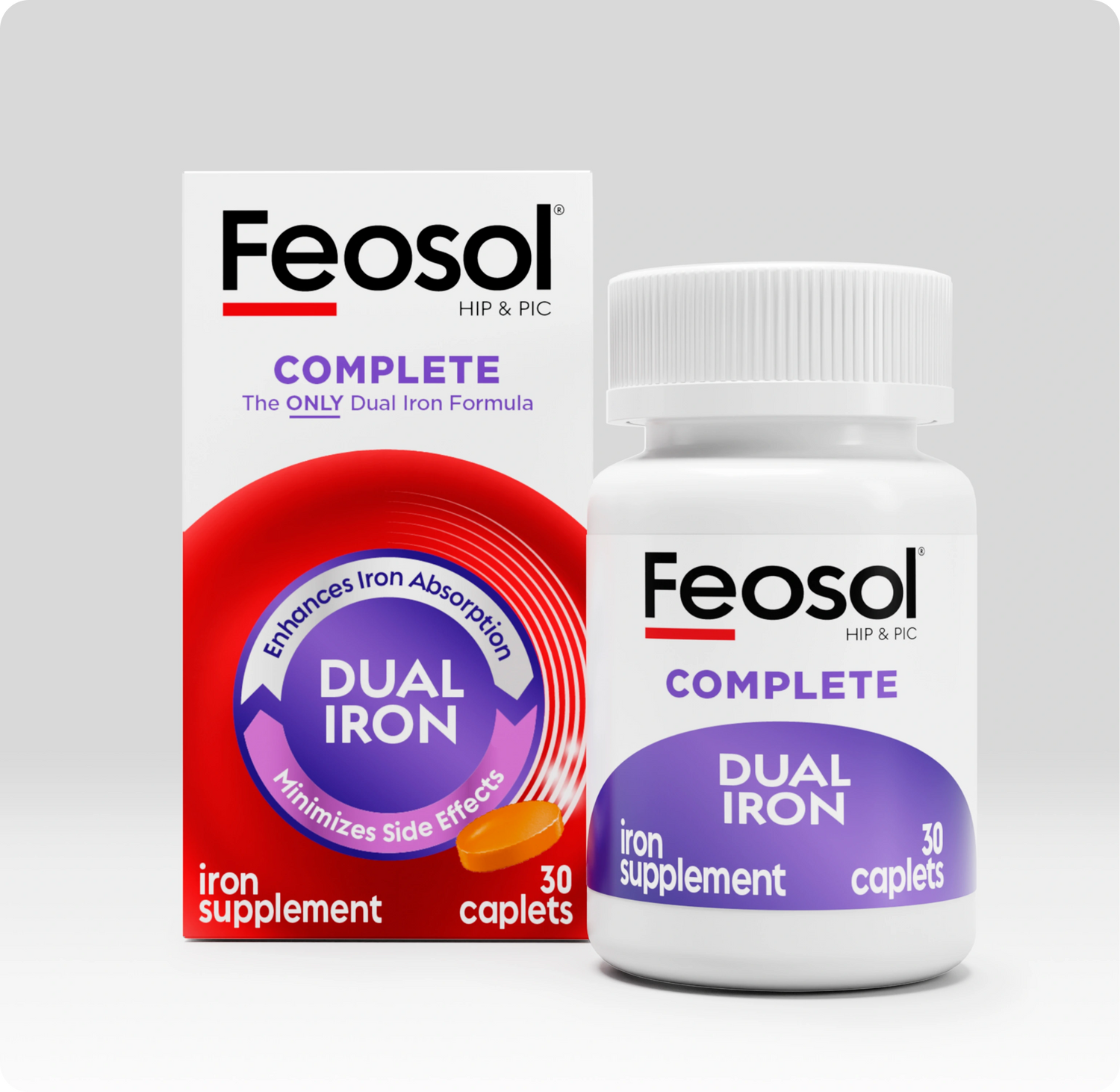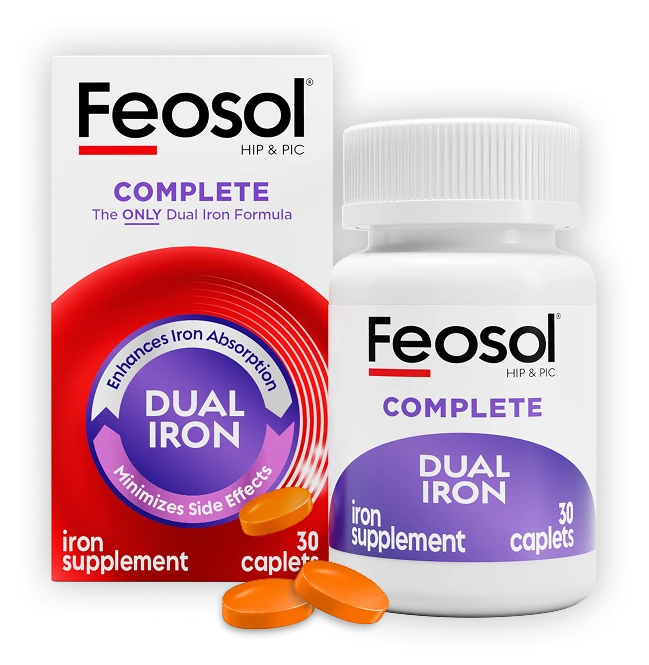Exploring the Science of Feosol® Complete
Trusted Iron Supplement for 70+ years
The Feosol® brand is a recommended iron supplement by pharmacists and a trusted leader and innovator of iron supplements for over 70 years.
Feosol® Complete contains Bifera® iron to help enhance absorption. Each Feosol® Complete small, coated iron caplet contains 28 mg of iron which provides 156% of Daily Value. This Bifera® iron supplement is gentle on the system, vital for red blood cell formation, and can help ease mild fatigue, weakness and dizziness from iron deficiency so you can thrive.




Feosol® COMPLETE Features

-
High Absorption Iron*
Each Feosol® Complete caplet is a patented form of iron that is gentle on the system and helpful for those that have an iron deficiency.
-
Bifera® Iron*
This Bifera® iron supplement contains heme and non-heme iron from animal and plant-based sources, which enhances absorption, is gentle on your digestive system and minimizes side effects such as constipation and nausea.
-
Blood Builder Benefits*
Just one Feosol® Complete Iron Supplement caplet every day helps support red blood cell production, energy, and a healthy immune system.*
-
Easy-To-Swallow
Small, coated tablets and caplets in both lines are designed for effortless consumption.
-
Made in USA
Feosol® has been a trusted leader and innovator of iron supplements for over 70 years.
Did You Know...



Why We Are Dedicated To Spreading Information About Iron Deficiency
Feosol® Complete FAQs
What makes Feosol® Complete different from other iron supplements?
What makes Feosol® Complete with Bifera® different from all other iron supplements is its unique, patented dual-iron formula.
Unlike other supplements, Feosol® Complete is the only iron supplement that contains both Heme Iron Polypeptide (HIP) and Polysaccharide Iron Complex (PIC).
HIP is a heme-based iron, like the kind you might find in a juicy steak, while PIC is a non-heme iron, like the kind you might find in peas or potatoes. When combined, heme iron and non-heme iron work synergistically to restore the body’s iron stores while minimizing the usual side effects associated with oral iron supplementation.
Because HIP and PIC iron are absorbed by different mechanisms, a supplement like Feosol® Complete with Bifera® containing both forms of iron allows for maximum absorption.
Feosol® Complete is also an excellent choice of iron supplement for those with sensitive systems because it restores iron levels while minimizing common GI side effects, such as constipation, nausea, and stomach upset or discomfort.
Is the iron in Feosol® Complete a heme iron or non-heme iron?
Feosol® Complete with Bifera® is a patented iron supplement that contains both heme (protein-based) and non-heme (inorganic or plant-derived) forms of iron in one small, daily iron supplement! You get the best of both worlds in one pill:
- One iron is heme iron polypeptide (HIP)
- The other iron is polysaccharide iron complex (PIC)
Good news: with Feosol® Complete you can achieve enhanced iron absorption because HIP and PIC iron are absorbed by two different mechanisms in your digestive tract.
Why does Feosol® Complete contain two different forms of iron?
Feosol® Complete with Bifera® combines two different forms of iron because together they deliver the best of both worlds: heme iron plus non-heme iron in one supplement enhances absorption while minimizing GI side effects!
Traditional oral iron supplements that you’ll find on the shelf at the drug store contain only one form of iron, usually a non-heme iron like ferrous sulfate.
The two forms of iron found in Feosol® Complete iron caplets – heme and non-heme (also known as HIP and PIC iron) – work together to enhance iron absorption in your body while minimizing common GI side effects, such as nausea and constipation. That means your body gets the iron that it needs, but it’s gentle on the stomach.
Heme iron is the type of iron you would find in meat, poultry, and fish, while non-heme iron is the type found in plant-based foods like vegetables and grains. Feosol® Complete provides two forms of iron for iron-deficient individuals who need the energy and nutritional benefits provided by both heme iron and non-heme iron.
One study shows that heme iron offers 25 times greater absorption than a non-heme iron. A separate clinical research study found that heme iron in combination with non-heme iron work synergistically to increase iron absorption up to 40%.
How does Feosol® Complete work?
Enhanced iron absorption is possible when two different forms of iron – heme and non-heme – are taken together. These two types of iron may be absorbed through different mechanisms in the small intestine, enabling maximum absorption of iron, thus helping replete iron stores and restore energy in iron deficient people.
Unlike any other iron supplement
How much elemental iron does Feosol® Complete contain?
Feosol® Complete with Bifera® iron supplement contains a total of 28 mg of elemental iron. It contains:
- 22 mg as PIC (Polysaccharide Iron Complex) and
- 6 mg as HIP (Heme Iron Polypeptide as Proferrin®)
Proferrin® is a registered trademark of Colorado Biolabs, Cozad, NE.
What is "Bifera®"? Is it a type of iron?
Feosol® Complete with Bifera® was formerly a brand of dietary iron supplements called Bifera®.
In 2012, the well-known iron brand Feosol® expanded its family of iron products to include Feosol® Complete with Bifera®.
The popular, gentle formula known as Bifera® has not been altered one bit – only the name and package have been improved to help you select the right iron for you. (We know you’ll love it!)
The two forms of iron in Feosol® Complete with Bifera® are called HIP (or Heme Iron Polypeptide) and PIC (or Polysaccharide Iron Complex). No one else offers this patented, iron-rich combo.
High Fiber Diets make it harder to absorb iron,and vegetarians and vegans may not be getting enough iron.
Why should I choose Feosol® Complete iron supplement?
If you have a sensitive system, you might find that Feosol® Complete with Bifera® is a gentle iron alternative that minimizes GI side effects such as constipation and nausea.
Here are the reasons we love Feosol® Complete with Bifera®:
- It’s gentle! Feosol® Complete offers the potential for greater iron absorption while minimizing the typical GI side effects like nausea and constipation.
- It’s an innovative patented iron supplement which is available over-the-counter.
- Unlike other OTC iron supplements that only include non-heme iron, Feosol® Complete has a dual action iron formula of heme iron plus non-heme iron. Two is better than one!
- It’s small and easy-to-swallow.
- No metallic aftertaste!
- You can take it with or without food, and you don’t have to combine with vitamin C to enhance absorption.
- It’s gluten-free.
Is Feosol® Complete a gluten-free iron?
Yes, Feosol® Complete is a gluten-free iron supplement.
If you are searching for a gluten-free iron supplement, Feosol® Complete with Bifera® is an appropriate iron alternative for those with a gluten intolerance (also known as Celiac disease).
Many people associate gluten with bread, crackers and beer. They’re on the right track – gluten is a very common protein found in wheat, rye and barley.
Real Reviews from Real Customers
Delivers exactly what it advertises!
"I have had difficulty finding an iron supplement that my body absorbs and I’m so grateful that I found this. Furthermore, I have not had any abdominal discomfort, nausea, or other symptoms that usually come with iron. I will be sticking with this for some time."
This iron supplement is gentle and effective!!
"The Feosol® Complete has been gentler on my system and has kept my iron levels in the normal range. For these reasons, I am extremely satisfied!!"
Feosol® complete!! The best!!
"Feosol® complete!!! The purple box!! The best source of iron in the world! It will also give you energy!!! Please try it!! You won't regret it!!"





